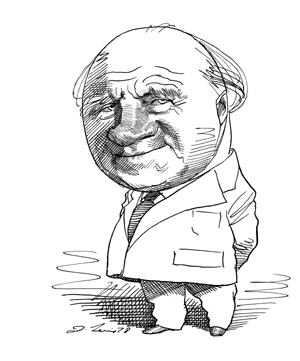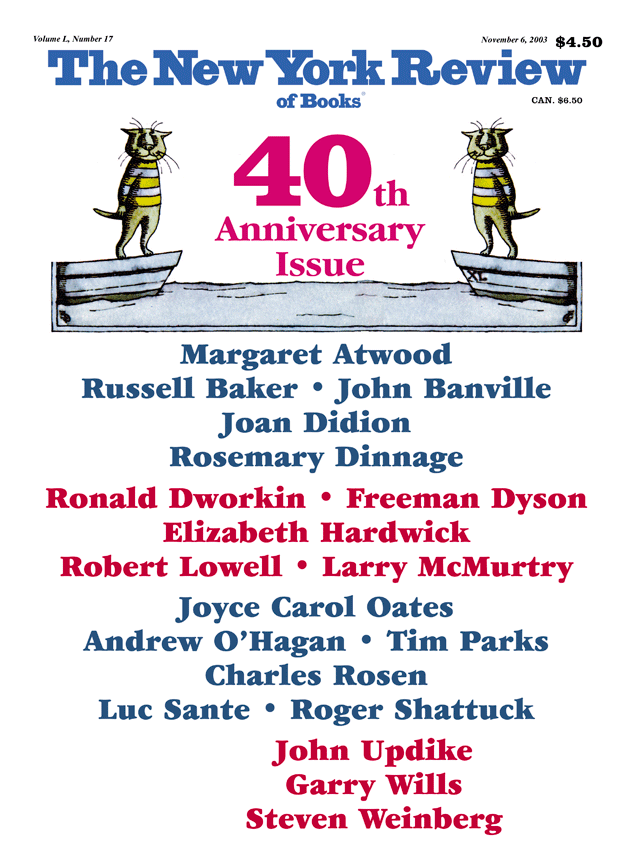To the Editors:
In his very interesting commentary on Heisenberg’s recently released letter to his wife from Copenhagen [NYR, August 14], Thomas Powers informs us that “Heisenberg apparently broke all the rules of security to tell his friend [Bohr] about the progress of German research…”—presumably on nuclear weapons. While we can never know exactly what Heisenberg told Bohr, we can know exactly what he didn’t tell him. He did not tell him that the Germans understood the role of “plutonium” as a fissionable explosive and, in particular, the role that reactors play in this. I will explain the quotation marks around “plutonium” after I explain how we know that Heisenberg did not tell Bohr about these things in Copenhagen. The reason we can be sure of this is that when Bohr left Denmark for England in the fall of 1943 he still did not know, as has been attested to by several people, including his son Aage, who were with Bohr at that time. It is confirmed in a letter that Aage Bohr sent to Powers on November 16, 1989, in which he wrote, “Heisenberg certainly drew no sketch of a reactor during his visit in 1941. The operation of a reactor was not discussed at all.”1 At the time of Heisenberg’s visit, as I will now point out, the Germans knew full well that reactors are used to manufacture plutonium.
On July 17, 1940, Heisenberg’s protégé C.F. von Weizsäcker sent a five-page document to German Army Ordnance proposing what he called Eka-Rhenium as a nuclear explosive. Eka Rhenium is what we now call “neptunium.” It was soon realized that it decayed into plutonium, an element that had advantages over uranium. On February 26, 1942, a few months after his return from Copenhagen, Heisenberg delivered a lecture at the House of German Research in which he had the following to say about element 94—plutonium:
As soon as such a machine [reactor] is on operation, the question of how to obtain explosive material, according to an idea of von Weizsacker, takes a new turn. In the transmutation of the uranium in the machine, a new substance comes into existence, element 94, which very probably—just like 23592U [uranium 235—the fissionable isotope]—is an explosive of equally unimaginable force. This substance is much easier to obtain from uranium than 23592U, however, since it can be separated from uranium by chemical means.2
None of this did he tell Bohr. We can only conjecture what might have happened in the German program if Heisenberg had been able to make a functioning nuclear reactor capable of producing plutonium.
Jeremy Bernstein
Aspen, Colorado
To the Editors:
I read with interest in Thomas Powers’s article Heisenberg’s letter to his wife written from Copenhagen after his famous (or infamous) meeting with Niels Bohr in September 1941. If it reveals anything, it is Heisenberg’s colossal insensitivity.
An important clue to the context of that famous meeting has been supplied by Arnold Kramish, physicist and later chronicler of the history of nuclear weapons. In 1941 an article appeared in the Swedish newspaper Stockholms-Tidnigen describing an effort in the United States to build a new type of bomb, out of uranium, with unprecedented explosive power. This news was picked up by the Press Branch of the German Foreign Office, headed by Dr. P.K. Schmidt. He forwarded the report to the physicist Carl von Weizsäcker, Heisenberg’s associate on the German uranium project, and son of the German Foreign Minister Ernst von Weizsäcker.
On September 4, 1941, Carl von Weizsäcker informed the Intelligence Branch of the German High Command and Bernhard Rust, minister in charge of the German uranium project. Within two weeks a scientific visit of Heisenberg and Weizsäcker to Copenhagen was arranged. The evidence is overwhelming that the real purpose of the visit was to find out what Bohr knew about the American effort.
It is ironical that the report in the Swedish newspaper was premature; the American uranium project did not start until 1942, so there was nothing Heisenberg could have learned from Bohr. But Bohr found out that the Germans had an active uranium project, which he duly reported to the leaders of the Manhattan Project in 1943 after his escape to America.
Powers reports that according to Elisabeth Heisenberg her husband’s strongest motivation for the trip was to prevent the use of atomic bombs on Germany. Indeed, had that happened, Heisenberg would have faced the fury of the Führer for failing to build such a weapon for the Reich.
Peter D. Lax
Professor Emeritus
Department of Mathematics
New York University
New York City
Thomas Powers replies:
We may not know “exactly” what Heisenberg told Bohr during their meeting in Copenhagen in 1941, but we do know that it included the alarming news that work was proceeding in Germany on the development of an atomic bomb, and that Heisenberg believed the project might succeed if the war lasted long enough. “Unfortunately,” Heisenberg writes in his memoir, Physics and Beyond, “as soon as I mentioned the mere possibility of making atomic bombs, Niels became so horrified that he failed to take in the most important part of my report, namely, that an enormous technical effort was needed. Now this, to me, was so important precisely because it gave physicists the possibility of deciding whether or not the construction of atom bombs should be attempted.”
Advertisement
Heisenberg makes it clear that the conversation ended there, and Jeremy Bernstein is probably right that Heisenberg had no chance to tell Bohr in detail how a working nuclear reactor might be used to produce the fissionable material required by bombs. Bernstein does not say why he is stressing this point, but I believe he wishes to demonstrate that Heisenberg really knew how a bomb could be built. On this point we certainly agree; indeed, Heisenberg himself stressed that it was the success of reactor experiments in the summer of 1941 which convinced his small research group that it now confronted “an open road to the atomic bomb.”
But how should they deal with this possibility? If bombs were simply impossible to build, as Bohr thought he had proved before the war, then it made no difference whether Heisenberg and his friends busied themselves with atomic research. The discovery that a nuclear reaction in natural uranium would create an unstable new element, which in turn would soon decay into a still heavier fissionable material that could be used in bombs (plutonium), meant that bombs were not so difficult to build after all—still difficult, but not impossibly difficult. How scientists ought to deal with this reality was the question that brought Heisenberg to Copenhagen in September 1941, but the conversation with Bohr failed, as we have seen, and Heisenberg had to decide what to do on his own.
In February 1942, as Bernstein points out, the technical aspects of plutonium production were discussed by Heisenberg at a conference in Berlin, but with officials he stressed the uncertainty and expense of trying to use the new material—as yet only a theoretical possibility—for the building of bombs. By the end of the month German military interest in atomic bombs was dead. An attempt by other scientists to revive the effort in June ended once and for all when Heisenberg convinced Albert Speer, in charge of economic mobilization for the war, that “the physicists themselves didn’t want to put much into it.
By “Heisenberg’s colossal insensitivity” I presume Professor Lax is referring to Heisenberg’s hope in September 1941 that the war and the German occupation of Denmark would not have ended his friendship with Niels Bohr, nor precluded the possibility that they might still speak openly and honestly to each other. In the event Heisenberg was wrong on that point, and if he had known it in advance he probably never would have gone to Copenhagen.
Arnold Kramish’s report of the Swedish press dispatch and what Carl Friedrich von Weizsäcker did with it can be found in Kramish’s book The Griffin, published in 1986. The book contains some interesting material, and some that is hard to verify; Kramish’s sourcing is erratic and often so vague as to be useless. The Swedish press dispatch, for example, is undated, and the letters of Schmidt and Weizsäcker are not sourced at all, unless they are among “the key intelligence documents…to be found in the archives of the Manhattan Project in the US National Archives.” The Manhattan Project files would fill an airplane hangar.
But even taken at face value the evidence offered by Lax strikes me as underwhelming “that the real purpose of the visit was to find out what Bohr knew about the American effort.” For whom were they trying to find out? If they were on some kind of official intelligence mission there ought to be evidence of it in the files of the German bomb project, one or more of the various German intelligence agencies, the Foreign Ministry, Hitler’s personal office, and perhaps other agencies as well. Intelligence agencies record everything before, during, and after any operation in voluminous detail, and the great bulk of German files survived the war. And if Heisenberg and Weizsäcker were trying to find out what Bohr knew for themselves, so what?
The best evidence for what Heisenberg had in mind in going to Copenhagen is to be found in what he did afterward, and what he did, in a meeting with Albert Speer in June 1942, was to kill official Nazi hopes of building an atomic bomb once and for all. It does not seem to me that Professor Lax has fully grasped this point: the German program to develop atomic weapons, begun with enthusiasm by the German army’s Ordnance Office in September 1939, came to an end when Heisenberg convinced Speer that the physicists thought the effort was too big, too expensive, and too uncertain for Germany to undertake in wartime. It was Heisenberg who did this, not somebody else.
Advertisement
This Issue
November 6, 2003



